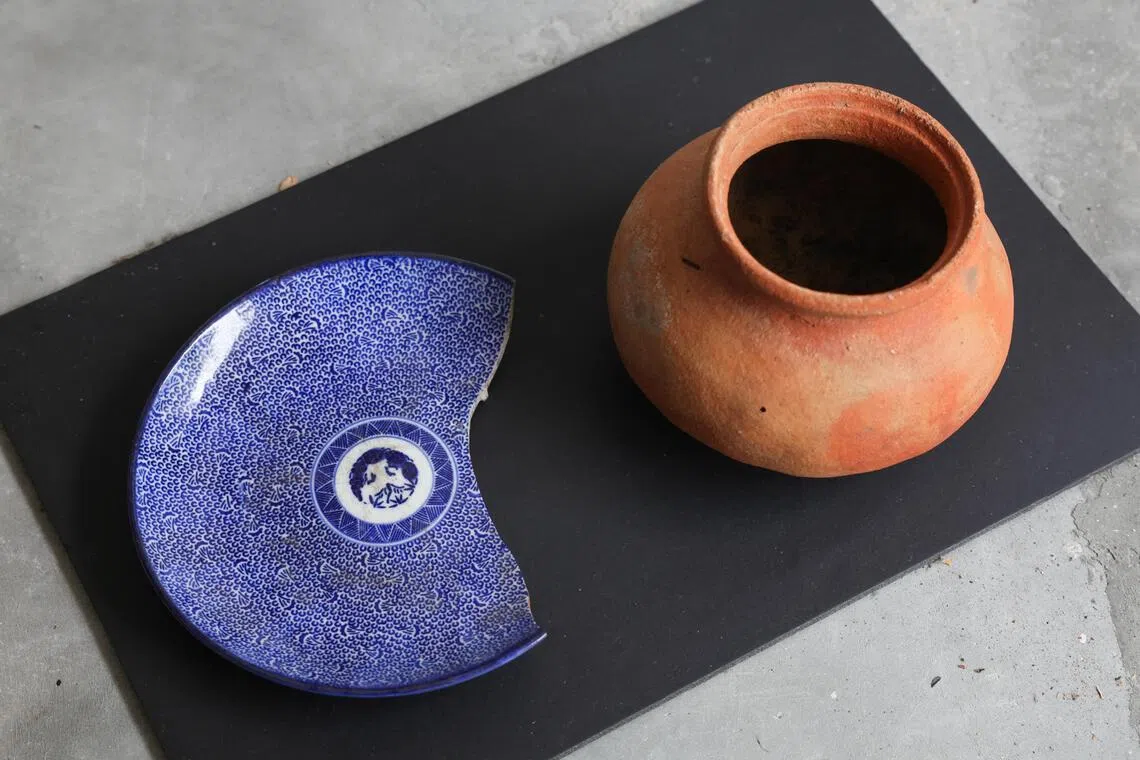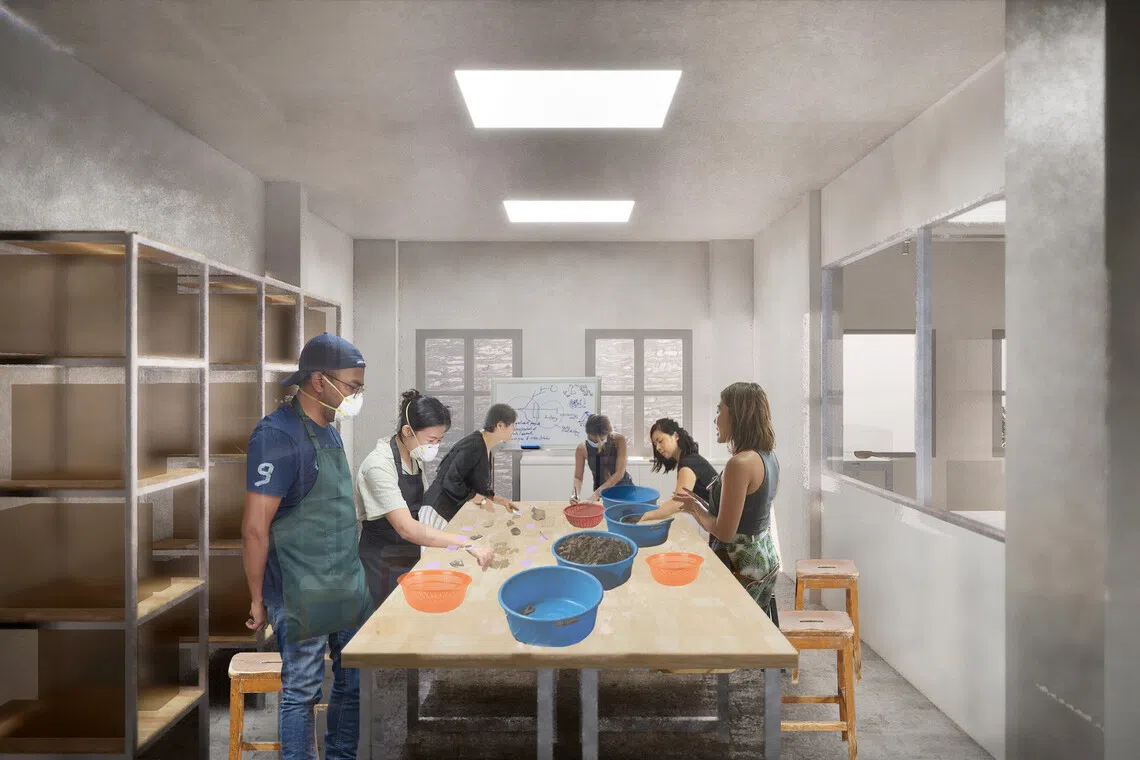Learn to work with Singapore’s archaeological finds at new heritage centre in Jalan Sultan
Sign up now: Get ST's newsletters delivered to your inbox

ArCH Square centre manager Natalie Tan (left) and assistant centre manager Zinnurain Nasir at the centre's new space at 125 Jalan Sultan.
ST PHOTO: GIN TAY
Follow topic:
- ArCH Square, a new centre by HeritageSG, will open in November to give the public access to Singapore's archaeology and intangible cultural heritage.
- The centre will feature displays of artefacts, such as a 19th-century uri pot, and host workshops by intangible cultural heritage practitioners.
- Public workshops will train participants to process artefacts unearthed in Singapore.
AI generated
SINGAPORE – In 2015, 2.5 tonnes of Chinese ceramics, coins and other artefacts
A decade later, the majority of the finds have yet to be cleaned, analysed and documented. They sit in a secure facility at an undisclosed location in Singapore, waiting to be processed.
From December, members of the public will get a chance to chip away at this backlog – many of them sherds – at a new archaeology and intangible cultural heritage centre called ArCH Square. The centre by HeritageSG, a subsidiary of the National Heritage Board
Ms Natalie Tan, ArCH Square’s centre manager, said its goal is two-pronged – to give the public more access to Singapore’s archaeology collections, and to be a home for the country’s intangible cultural heritage practitioners.
Intangible cultural heritage refers to traditions or living expressions that are inherited and passed down through generations, such as the performing arts, social practices, rituals and festive events.
Currently, Singapore has two intangible cultural heritage elements inscribed on the Unesco Representative List of the Intangible Cultural Heritage of Humanity – the hawker culture and the kebaya, which was a joint nomination with
The Republic also submitted a joint nomination with Malaysia for the Chingay parade
ArCH Square will be at 125 Jalan Sultan, a state property and conservation shophouse that HeritageSG has leased from the Singapore Land Authority for three years starting from 2025, with the possibility of two three-year extensions.
The property has about 5,000 sq ft of space over two storeys.
Ms Tan said there are synergies between archaeology and intangible cultural heritage.
“Archaeology is the study of material culture, and when you study material culture and its history, you are informed about how practices have evolved, and this helps to ground your own identity,” she said, citing a 19th-century uri pot which will be displayed at ArCH Square as an example.
The earthenware pot, which was recovered from an archaeological dig at Sultan Gate in Kampong Gelam in 2017, is believed to have been used by a Muslim family to bury an umbilical cord and placenta after a birth – a practice consistent with an Islamic belief that parts separated from the human body should be buried.

A porcelain plate (left) and an uri pot are among the artefacts that will be on display at ArCH Square.
ST PHOTO: GIN TAY
Ms Tan said that upon hearing about the uri pot and the practice of burying umbilical cords, a Chinese colleague said she also kept an umbilical cord, but in a red packet.
“The ritual of keeping the umbilical cord is something that we practise, but nobody really talks about it. But once we mention it, everyone says ‘I also do it’,” she said.
“That is what we feel we have come across time and time again in our journey developing this centre. There are so many rabbit holes we can go down.”
The centre will have a space for permanent and rotating displays on the first of its two floors, curated by Mr Zinnurain Nasir, ArCH Square’s assistant manager and only other full-time employee.
Mr Zinnurain said the artefacts will be curated with seven themes in mind, a range that he believes caters to the varied interests of visitors and allows for various interpretations of what is on display.
The themes include ritual and life cycles – characterised by the uri pot – as well as craft and transmission, focusing on carving, pottery and ceramic skills passed down through generations.

ArCH Square will be housed in a two-storey conservation shophouse at 125 Jalan Sultan (centre).
ST PHOTO: GIN TAY
Intangible cultural heritage practitioners will have a space at ArCH Square for programmes and events, allowing them to run workshops and showcase their craft through exhibitions, Ms Tan said. Practitioners who wish to rent the spaces can do so at 60 per cent off corporate rates.
She noted that in NHB’s engagements, heritage practitioners often expressed a desire for a dedicated space for them, just as the arts sector has spaces such as Aliwal Arts Centre and Stamford Arts Centre.
Ms Tan said that about five practitioners have already expressed interest in using the space, including an effigy maker, a rangoli artist and batik artists.
ArCH Square will also house an archaeology lab that will occupy about a third of the first floor, where members of the public will be trained to process archaeological artefacts at four-week-long workshops called Archaeology 101.
The workshops, which are slated to begin in December, comprise four 90-minute sessions, and can each accommodate five participants. More details are still being worked out.

An artist’s rendering of ArCH Square’s space for archaeology workshops.
PHOTO: ARCH SQUARE
After completing these workshops, participants can join NHB’s existing pool of about 50 volunteers who help to process Singapore’s terrestrial archaeological discoveries on an informal basis.
Volunteers may work on artefacts from previous terrestrial digs in Singapore at twice-weekly sessions held at ArCH Square, on Wednesdays and Saturdays.
Workshops will be facilitated by volunteers from this existing pool – some of whom have previously undergone archaeology training.
Raising public awareness of archaeology and developing local capabilities have been a focus of NHB in two successive five-year plans, the latest of which was launched in 2023
Ms Asmah Alias, director of galleries, exhibitions and museums at HeritageSG, noted that developing the archaeology sector in Singapore takes time, and that ArCH Square is an “important first step”.
“It offers Singaporeans, particularly younger generations, an entry point to understand our shared past, explore what it means for them today, and see how archaeology contributes to identity and sense of place,” she said, adding that such exposure may eventually broaden the pipeline for future talent in the field.
NHB said it has partnered institutes of higher learning to develop local capabilities and support research to develop local archaeological capabilities.
“Since 2020, we have collaborated with Nanyang Technological University to support six Singaporean students and their Master of Arts dissertations related to Singapore archaeology, as well as the post-excavation processing and publishing of reports and databases of local archaeological sites,” said the board, which added that it will continue with such efforts.


